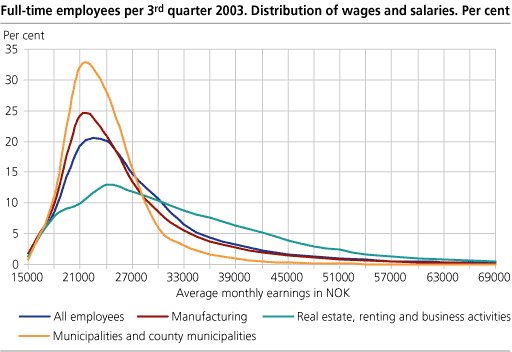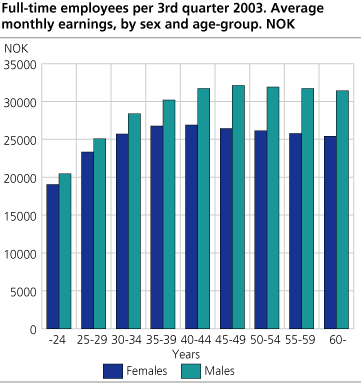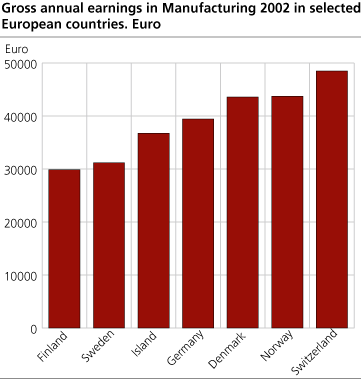Content
Published:
This is an archived release.
Monthly earnings up NOK 900
Average monthly earnings for all employees were NOK 27 300 per 3rdquarter 2003. This was a NOK 900 or 3.5 per cent increase from the previous year. This statistic covers all employees.
Full-time employees increased their monthly earnings by 3.4 per cent to NOK 28 100. In comparison, full-time equivalents of part-time employees amounted to NOK 23 200, which was a 4.3 per cent increase.
|
Full-time equivalents, all employees. Average monthly earnings
per 3rd quarter 2002 and 2003. NOK |
| Working hours | Employees covered by the census | Monthly earnings, total | Percentage change | ||||||||||||||||||||||||||||||||||||
|---|---|---|---|---|---|---|---|---|---|---|---|---|---|---|---|---|---|---|---|---|---|---|---|---|---|---|---|---|---|---|---|---|---|---|---|---|---|---|---|
| 2002 | 2003 | 2002 | 2003 | 2002-2003 | |||||||||||||||||||||||||||||||||||
| Total | 1 286 165 | 1 282 462 | 26 357 | 27 283 | 3.5 | ||||||||||||||||||||||||||||||||||
| Full-time | 857 776 | 857 787 | 27 232 | 28 145 | 3.4 | ||||||||||||||||||||||||||||||||||
| Part-time | 428 389 | 424 675 | 22 273 | 23 240 | 4.3 | ||||||||||||||||||||||||||||||||||
Only small changes in bonuses and allowances
Monthly earnings include basic paid wages and salaries, variable additional allowances, bonuses and commissions and the like. Overtime pay and other benefits are not included.
Most of the increase in average monthly earnings was due to increases in basic paid wages and salaries. Bonuses, allowances and the like are almost unchanged from 2002 at NOK 1 300 per month. In the sections Oil- and gas extraction and mining, Financial intermediation and Real estate, renting and business activities the bonuses increased by NOK 600, 300 and 200, respectively. This was, however, not enough to make an impact on the total.
Dispersion in wages and salaries
Tables 1-3 show the lower quartile, median, mean and upper quartile of the average monthly earnings for full-time employees. The median divides the population in two evenly sized parts, where one half earns less and the other more than the given amount. The difference between the mean and the median gives a fairly good indication of the distribution of wages and salaries.
For all full-time employees this difference was NOK 2 800 per 3rd quarter 2003. In Manufacturing it was NOK 2 700, while in Real estate, renting and business activities the difference was NOK 3 200.
Figure 1 illustrates the distributions of wages and salaries in Manufacturing, Real estate, renting and business activities and Municipalities and county municipalities.
Differences between males and females
Figure 2 shows differences between full-time employed males and females, by age group. The differences increased with increasing age, from 7 per cent to 19 per cent for the above 60-age-group. In total for all employees the average difference was close to 16 per cent, with part-time employees calculated as full-time equivalents. The figure for full-time employees was 14 per cent and for part-time employees just above 5 per cent.
International figures
Figure 3 shows the gross annual earnings in Manufacturing 2002 in some European countries.
Table 6 presents an extended list of countries.
It is important to note that exchange rate fluctuations throughout the year can greatly affect the wage levels in Euros. This should be accounted for when comparing countries.
More tables in StatBank Norway
In addition to the tables below, tables by section, educational level and age-groups for all as well as full-time and part-time employees can be found here: StatBank Norway
About the statistical basis
The statistics are based on information from a sample of enterprises with a total of 1 282 462 employees per 3rd quarter 2003. It covers all sections except for agriculture, hunting and forestry (A) and fishing (B). The data for this statistics have not been collected separately, but is an assembly of previously published statistics for the individual sections.
According to preliminary figures from the National Accounts for the 3rd quarter of 2003, the statistics cover about 2 017 100 employees.
Tables:
- Table 1 Full-time employees. Average monthly earnings. Lower quartile, median, mean and upper quartile, by sex and section per 3rd quarter 2003. NOK
- Table 2 Full-time employees. Average monthly earnings. Lower quartile, median, mean and upper quartile, by sex and section per 3rd quarter 2002. NOK
- Table 3 Full-time employees. Average monthly earnings. Lower quartile, median, mean and upper quartile, by sex and section per 3rd quarter 2001. NOK
- Table 4 All employees. Average monthly earnings, by working hours and deciles per 3rd quarter. 1998-2003. NOK and proportion of sum per cent
- Table 5 Full-time employees. Average monthly earnings, by sex and section per 3rd quarter. 2001-2003. NOK and percentage change
- Table 6 Full-time employees in private sector. Gross annual earnings, by country. 2001 and 2002. Euro
Additional information
Contact
-
Arbeidsmarked og lønn
E-mail: arbeidsmarked@ssb.no
-
Knut Snellingen Bye
E-mail: knut.snellingen.bye@ssb.no
tel.: (+47) 40 81 13 26
-
Magnus Berglund Johnsen
E-mail: magnus.johnsen@ssb.no
tel.: (+47) 40 90 23 75
-
Fredrik Steinrem Edelmann
E-mail: fredrik.edelmann@ssb.no
tel.: (+47) 40 90 24 60
-
Knut Håkon Grini
E-mail: knut.grini@ssb.no
tel.: (+47) 48 20 51 63



